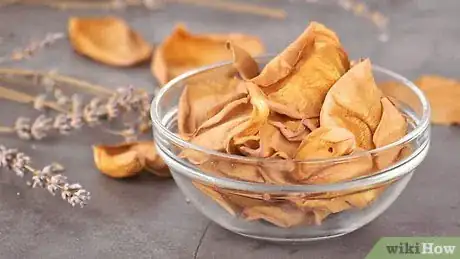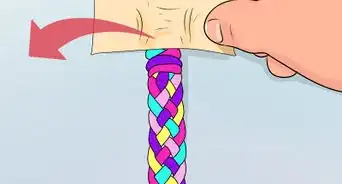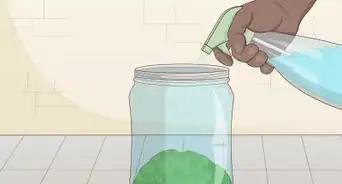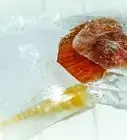This article was co-authored by Lois Wade and by wikiHow staff writer, Jessica Gibson. Lois Wade has 45 years of experience in crafts including sewing, crochet, needlepoint, cross-stitch, drawing, and paper crafts. She has been contributing to craft articles on wikiHow since 2007.
There are 13 references cited in this article, which can be found at the bottom of the page.
wikiHow marks an article as reader-approved once it receives enough positive feedback. In this case, 86% of readers who voted found the article helpful, earning it our reader-approved status.
This article has been viewed 145,059 times.
Whether you're making gifts, practicing sewing skills, or freshening up your linen drawers, making sachets is a great project. You can customize your fabric, sew the sachet in any shape, and fill it with your choice of wonderful scents. If you don't have time or sewing skills, don't worry! Just use a small fabric bag and wrap a ribbon around the top to close your quick sachet pouch.
Things You Should Know
- Cut 2 squares of fabric and sew them together inside out along the edges, leaving a 1.5 in (3.8 cm) opening, then flip the bag right-side out.
- Choose potpourri, rice scented with essential oils, or dried flower petals and herbs for your custom scented filling.
- Add your filling to the bag, then seal it by stitching the opening or tying it closed with a ribbon.
Steps
Making a Sachet Pouch
-
1Buy a lightweight bag to use as a sachet if you don't want to sew the pouch. You don't have to have sewing skills to make sachets! Buy a package of small muslin bags or use paper tea filters that you can fill with your scented mixture. Then, you can tie off the open end with a ribbon and enjoy your sachet without any sewing at all.[1]
- Use any lightweight bag that you have on hand. If it's made of mesh, check that your choice of filling won't spill through the holes in the bag before you fill it.
-
2Fold a piece of paper into a pouch to make a quick no-sew sachet. Take a rectangular piece of sturdy paper and fold it in half. Secure the long sides with double-sided tape to make a rectangular pouch that you can fill.[2]
- Use colorful scrapbooking paper to create a beautiful, customized sachet.
Advertisement -
3Cut 2 fabric squares in the size and shape you want to sew a sachet. You don't need a fancy pattern to make a sachet; all you need is some lightweight fabric. Decide how big you'd like to make your sachet and cut 2 equal-sized square pieces. For a small sachet, cut a few 5 in (13 cm) squares or cut 7 in (18 cm) squares for a larger sachet.[3]
- Chintz, muslin, organza, and cotton calico are good lightweight fabrics for sachets since they're thin enough to release the fragrance.
- Feel free to cut your fabric into any shape. To make rectangular, heart-shaped, or circular sachets, cut 2 equal pieces that you can sew together.
-
4Stack the fabric squares so the wrong sides face out. Lay the squares on top of each other so the patterned sides touch. This means that you'll be sewing the wrong side so when you're done, you can turn the sachet right side out.[4]
- You don't need to pin the squares unless it makes you feel more comfortable as you sew.
-
5Sew along the sides of the fabric square and leave a 1 1⁄2 in (3.8 cm) gap. Take your fabric to the sewing machine and start sewing a straight line down 1 side of the square. Leave a 1⁄2 inch (1.3 cm) seam allowance. Then, turn the square when you reach a corner and straight stitch along the other 2 sides. When you reach the final edge, leave a 1 1⁄2 in (3.8 cm) gap from where you started sewing.[5]
- You can sew the sachet by hand, but it might not be as sturdy as if you sew it with a machine.
- You'll use the gap to fill the sachet.
-
6Flip the fabric sachet right side out. Push the fabric through the gap you left so you can pull the right side of the sachet out. This way, the wrong side without the pattern is inside the sachet. Now you're ready to fill your sachet.[6]
- You can stick a skewer or knitting needle down into the corners to make them pointy if it's hard to reach them with your finger.
Choosing a Sachet Filling
-
1Mix 1 cup (200 g) of dry rice with 10 drops of essential oil for a custom scent. If you already have a few bottles of essential oils, use them to scent your sachet filling. Pour 1 cup (200 g) of dry rice into a bowl and stir in 10 drops of a single essential oil or a mix. For example, use 5 drops of lavender and 5 drops of rosemary for a woodsy-scented filling.[7]
- You can also pour the rice and essential oil into a large mason jar. Screw the lid on and shake it vigorously to coat the rice with the scent. This is a great task for kids to help out with!
- Play around with your favorite essential oil combinations. Try bergamot and grapefruit for a citrus scent or use peppermint for a festive winter filling.
- If you don't want to use rice, substitute the same amount of plain oats or cotton balls.
-
2Make or buy potpourri for a strong-smelling filling. Potpourri is a great filler for sachets since you can buy it ready-made or customize your own. For a spicy sachet, get potpourri that uses dried citrus peel, cloves, and cinnamon sticks, for instance.[8]
-
3Dry lavender and use the flowers as filling for a floral sachet. If you have a lavender plant, snip the purple tips from the green stems and spread the flowers on a kitchen towel. Leave the lavender at room temperature for a few days so the flowers dry out. Then, you can fill your sachets with the fragrant flowers.[9]
- Lavender flowers stay fragrant for years, especially if you add a few drops of lavender essential oil. If your sachet isn't smelling very strong, just massage the lavender filling to release more scent.
- Fill the sachet with your favorite dried herbs or flowers like eucalyptus, lilac, thyme, or rosemary.
-
4Spread fresh rose petals on a baking sheet to dry for a delicate sachet filling. Buy a dozen roses that have a strong fragrance or pick a dozen early in the morning when the petals are open. Pull off the petals and spread them on a rimmed baking sheet. Then, leave the petals at room temperature for about 4 days so the petals dry out completely.[10]
- To speed up the drying time, you could put the sheet of petals into the oven. Bake the petals at 275 °F (135 °C) for 10 minutes to dry them out.
-
5Buy cedar chips or shavings to make a moth-repelling filler. If you plan on putting sachets into a closet or clothing drawer, add cedar to your filling combination or use all cedar chips or shavings. The cedar naturally repels moths that can damage your clothes or fabric.[11]
- Pair cedar with lavender if you don't like the scent of cedar. Lavender can also repel moths and it masks some of the cedar smell.
Filling and Closing the Sachet
-
1Fill a paper pouch half full and tape the top edge closed. If you made a rectangular paper sachet, fill it no more than half full and fold the top edge over. Unfold the top edge and place a piece of double-sided tape on the inside. Then, fold the top edge onto the sachet to seal it closed.[12]
- It's a good idea to use several pieces of double-sided tape so none of the filling escapes.
-
2Spoon about 1/2 to 1 cup (100 to 200 g) of filling into the sachet bag. Make sure that your sachet bag has the pattern facing out before you fill it! Find the opening that you left and spoon your choice of filling into the sachet bag or pouch. Pour in enough filling to fill the sachet at least half full. Keep in mind that if you fill it completely full, it might be harder to close the sachet.[13]
- If it's easier, stick a small funnel into the sachet opening and slowly pour the filling through it. This works well with scented rice or lavender rather than chunky potpourri.
-
3Handstitch the fabric sachet closed. Thread a needle with thread that matches the color of your fabric and make a knot at the end of the thread. Insert the needle between the folded fabric near the seam. Then, sew back and forth between the folded edges of the fabric until you've closed the gap. This makes an invisible seam.[14]
- If you'd rather use your sewing machine to finish the sachet, don't fill the sachet completely full or you won't be able to sew across the gap. Instead, fill it half full and straight stitch right along the edge of the gap.
-
4Tie the sachet closed with a ribbon if you'd rather make a sachet pouch. If you don't want to sew the sachet closed or you're using a bag that you bought, fill your sachet only half full. Then, gather up the fabric at the top and wrap a ribbon tightly around it to secure the sachet. This makes a sachet pouch that you can lay flat or place into a linen drawer.[15]
- If you're worried that the ribbon might come undone, use a rubber band to secure the fabric before you wrap the ribbon around it.
Community Q&A
-
QuestionWhat are the best fabrics and sizes for sachets to deter mice? Preferably so rescenting does not require opening bags.
 Community AnswerUse a basic muslin/calico or cheescloth fabric (the mice don't need anything pretty) and make it about the size of a standard bar of soap. Fill with dried peppermint leaves (you can scent with peppermint oil as well), as mice do not like the odor of peppermint. You could also add cloves, cayenne pepper and/or pepper, as mice don't like those spices either. Keep the sachets anywhere you think mice might be entering and in places like under the bed, in cupboards and under the sink.
Community AnswerUse a basic muslin/calico or cheescloth fabric (the mice don't need anything pretty) and make it about the size of a standard bar of soap. Fill with dried peppermint leaves (you can scent with peppermint oil as well), as mice do not like the odor of peppermint. You could also add cloves, cayenne pepper and/or pepper, as mice don't like those spices either. Keep the sachets anywhere you think mice might be entering and in places like under the bed, in cupboards and under the sink. -
QuestionWhat kind of ingredients go inside of a homemade sachet?
 Community AnswerYou could try any sort of potpourri (see Make Potpourri for ideas), dried herbs, spice sticks/bark/seeds such as cinnamon or mace, soap (whole or in large shards), a commercial scented item, etc. Try a few things to see what suits your needs. Always be careful of anything that leaks, oozes or leaves marks though.
Community AnswerYou could try any sort of potpourri (see Make Potpourri for ideas), dried herbs, spice sticks/bark/seeds such as cinnamon or mace, soap (whole or in large shards), a commercial scented item, etc. Try a few things to see what suits your needs. Always be careful of anything that leaks, oozes or leaves marks though. -
QuestionWhat kind of fabric should I use?
 Community AnswerA wide range of fabrics are suitable for making sachets, such as cotton (usually the lighter weight versions), Swiss cotton, lightweight synthetic blends, organza, muslin, calico and such. Trial a small piece of fabric if you're not sure how it'll turn out, as it's an easy project you can make in a small size.
Community AnswerA wide range of fabrics are suitable for making sachets, such as cotton (usually the lighter weight versions), Swiss cotton, lightweight synthetic blends, organza, muslin, calico and such. Trial a small piece of fabric if you're not sure how it'll turn out, as it's an easy project you can make in a small size.
Things You'll Need
- Fabric
- Scissors
- Sewing machine or needle and thread
- Filling material like potpourri, cedar shavings, or lavender
- Decorative paper, optional
- Sewing pins, optional
- Ribbon, optional
- Funnel, optional
References
- ↑ https://www.chicagotribune.com/news/ct-xpm-1996-06-16-9606160384-story.html
- ↑ https://youtu.be/LdibgFzfRzI?t=247
- ↑ https://youtu.be/vd4z1nmtqXg?t=90
- ↑ https://youtu.be/vd4z1nmtqXg?t=103
- ↑ https://youtu.be/vd4z1nmtqXg?t=137
- ↑ https://youtu.be/vd4z1nmtqXg?t=198
- ↑ https://www.creativehealthyfamily.com/diy-natural-scented-sachets/
- ↑ https://youtu.be/xIM4D6UJR9A?t=86
- ↑ https://thenerdyfarmwife.com/uses-for-lavender-leaves/
- ↑ https://youtu.be/lDKkIUf0HFw?t=41
- ↑ https://www.chicagotribune.com/news/ct-xpm-1996-06-16-9606160384-story.html
- ↑ https://youtu.be/LdibgFzfRzI?t=307
- ↑ https://cpb-us-e1.wpmucdn.com/blogs.cornell.edu/dist/f/575/files/2016/07/newlogosachets-and-catnip-bags-renynl-1cnli1v.pdf
- ↑ https://youtu.be/LBYx51ipbFM?t=97
- ↑ https://cpb-us-e1.wpmucdn.com/blogs.cornell.edu/dist/f/575/files/2016/07/newlogosachets-and-catnip-bags-renynl-1cnli1v.pdf










-Step-11.webp)


















-Step-11.webp)


































